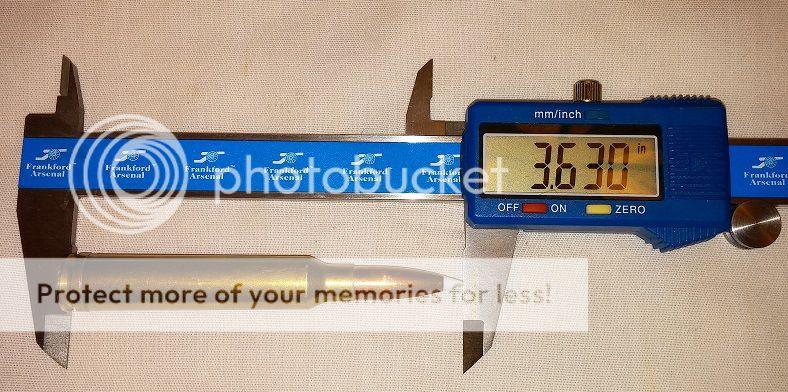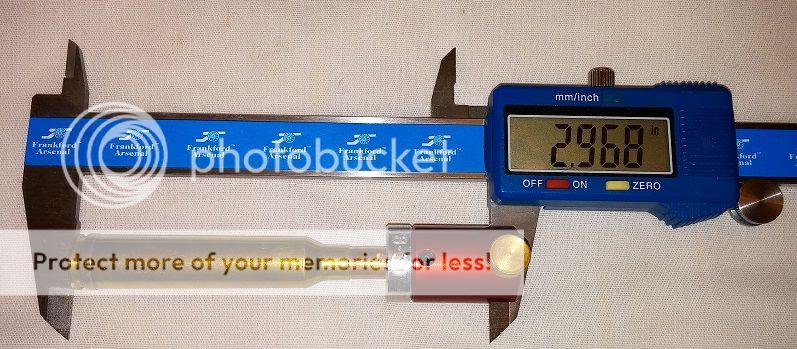engineer40
Well-Known Member
First I'd like to say that over the last couple weeks I have asked quite a few questions here in the reloading area of the forum and you guys have been super helpful. I am very grateful for the completely free help that the forum members here always provide so willingly. Thank you!
I got some interesting results with 3 different ways of measuring the max COAL for one of my 30-06's. This was my first attempt at measuring and customizing ammo. I tested both 168gr Noslers and 178gr Amax's.
At first I tried the method of lightly crimping a bullet way far out. The tension is enough to hold the bullet in place but loose enough that I can still push the round into the action with a stiff press on my bolt. I had lubed the ogives on the bullets so they would hopefully not stick to the rifling and give more accurate results when I would pull the cartridge back out.
Results using this method were the most spread out but were most in line with what I'm seeing for the OAL's in reloading manuals and what other people online are seeing for results.
168gr = 3.330 to 3.421
178gr = 3.317 to 3.336
This first method did not instill confidence in me for the results.
Now, the next 2 methods came out to the same results for both methods. Which you would think because both testing methods came out to the same results, this would have to be accurate. But the OAL's are so short. Shorter even than the OAL's listed in some reloading manuals.
168gr = 3.293
178gr = 3.290
The next method I tried was using cleaning rods. First you put the bolt all the way in and make sure it's cocked. Stick in the cleaning rod until it bottoms out and mark exactly where the barrel is on the cleaning rod with a piece of tape sideways so you're using the straight edge. I found it easy to get the piece of tape completely flush to the barrel. Take out the cleaning rod and the bolt. Then drop the bullet you are using into the barrel. Take a second cleaning rod and push the bullet all the way up to the lands and make sure it is tight up there and it touching. Now use the first cleaning rod again and stick it into the barrel again except this time it won't go in as far. Use another piece of sideways tape and mark that cleaning rod again exactly where the end of the barrel is. Finish by using calipers to measure the distance between the tapes. I used a plastic end on the cleaning rod to make sure the bullet tip wouldn't go into the hollow rod end. I tried this test many times and it always came out the same results with both bullets. Results above.
Similar to this method he uses in the second half of this video:
The third method involved trial and error with different bullet seating depths and using a sharpie to color the ogive area of the bullets. Chambering the rounds a few times each and seeing if the black sharpie has worn down from it riding the lands. I tried different seating depths and eventually came up with the results. Afterwards I compared and realized they were the same as the above method.
I guess I just typed a whole lot, but my real question is; are these results reasonable for a 30-06 with the bullets listed?
Nosler 168gr = 3.293
Amax 178gr = 3.290
My results just seem so short. And since my testing methods are "crude" I thought I would double check with you guys. Thanks!
I got some interesting results with 3 different ways of measuring the max COAL for one of my 30-06's. This was my first attempt at measuring and customizing ammo. I tested both 168gr Noslers and 178gr Amax's.
At first I tried the method of lightly crimping a bullet way far out. The tension is enough to hold the bullet in place but loose enough that I can still push the round into the action with a stiff press on my bolt. I had lubed the ogives on the bullets so they would hopefully not stick to the rifling and give more accurate results when I would pull the cartridge back out.
Results using this method were the most spread out but were most in line with what I'm seeing for the OAL's in reloading manuals and what other people online are seeing for results.
168gr = 3.330 to 3.421
178gr = 3.317 to 3.336
This first method did not instill confidence in me for the results.
Now, the next 2 methods came out to the same results for both methods. Which you would think because both testing methods came out to the same results, this would have to be accurate. But the OAL's are so short. Shorter even than the OAL's listed in some reloading manuals.
168gr = 3.293
178gr = 3.290
The next method I tried was using cleaning rods. First you put the bolt all the way in and make sure it's cocked. Stick in the cleaning rod until it bottoms out and mark exactly where the barrel is on the cleaning rod with a piece of tape sideways so you're using the straight edge. I found it easy to get the piece of tape completely flush to the barrel. Take out the cleaning rod and the bolt. Then drop the bullet you are using into the barrel. Take a second cleaning rod and push the bullet all the way up to the lands and make sure it is tight up there and it touching. Now use the first cleaning rod again and stick it into the barrel again except this time it won't go in as far. Use another piece of sideways tape and mark that cleaning rod again exactly where the end of the barrel is. Finish by using calipers to measure the distance between the tapes. I used a plastic end on the cleaning rod to make sure the bullet tip wouldn't go into the hollow rod end. I tried this test many times and it always came out the same results with both bullets. Results above.
Similar to this method he uses in the second half of this video:
The third method involved trial and error with different bullet seating depths and using a sharpie to color the ogive area of the bullets. Chambering the rounds a few times each and seeing if the black sharpie has worn down from it riding the lands. I tried different seating depths and eventually came up with the results. Afterwards I compared and realized they were the same as the above method.
I guess I just typed a whole lot, but my real question is; are these results reasonable for a 30-06 with the bullets listed?
Nosler 168gr = 3.293
Amax 178gr = 3.290
My results just seem so short. And since my testing methods are "crude" I thought I would double check with you guys. Thanks!
Last edited by a moderator:


